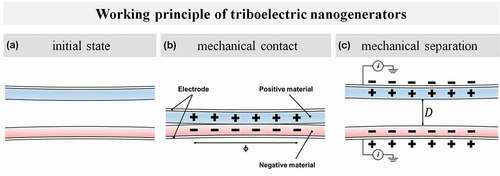Figures & data

Figure 1. Schematics of working principle of TENGs (a) Initial state: two different tribopositive/tribonegative materials present with a certain distance, (b) Mechanical contact: mechanically triggered objects make contact with surface area, Ф. Transient polarization at the surface level induced. (c) Mechanical separation: objects are separated with distance, D. Current flows in order to balance each temporarily unbalanced electrically polarized surface.

Figure 2. Schematics showing the importance of polarity for the triboelectric conversion characteristics. (a) Induced polarization on ferroelectrics characterized by KPFM, and (b) TENGs tuned as electropositive/electronegative ferroelectric polarity and electrical output characteristics. Reproduced by permission from [Citation22], copyright [2016, Wiley-VCH] (c) Well aligned polymer chain based TENGs, and (d) the impact on surface charge density characteristics depending on the chain length. (e) Conversion characteristics trend depending on the polarity of polymer. Reproduced by permission from [Citation23], copyright [2017, Wiley-VCH] (f) Nanocomposite structure capable of excessive polarity, and (g) controlled surface charge density through the level of polarity with its (h) working principle and (i) superior conversion characteristics beyond current TENGs materials. Reproduced by permission from [Citation24], copyright [2017, Wiley-VCH] (j) Electrolyte based TENGs materials controlled triboelectric charge, and (k) the electrical conversion characteristics. Reproduced by permission from [Citation25], copyright [2017, Wiley-VCH]
![Figure 2. Schematics showing the importance of polarity for the triboelectric conversion characteristics. (a) Induced polarization on ferroelectrics characterized by KPFM, and (b) TENGs tuned as electropositive/electronegative ferroelectric polarity and electrical output characteristics. Reproduced by permission from [Citation22], copyright [2016, Wiley-VCH] (c) Well aligned polymer chain based TENGs, and (d) the impact on surface charge density characteristics depending on the chain length. (e) Conversion characteristics trend depending on the polarity of polymer. Reproduced by permission from [Citation23], copyright [2017, Wiley-VCH] (f) Nanocomposite structure capable of excessive polarity, and (g) controlled surface charge density through the level of polarity with its (h) working principle and (i) superior conversion characteristics beyond current TENGs materials. Reproduced by permission from [Citation24], copyright [2017, Wiley-VCH] (j) Electrolyte based TENGs materials controlled triboelectric charge, and (k) the electrical conversion characteristics. Reproduced by permission from [Citation25], copyright [2017, Wiley-VCH]](/cms/asset/8f32ac46-400b-4745-bbd5-3771c0483a7f/tsta_a_1800366_f0002_oc.jpg)
Figure 3. Schematics of enhancing the initial stage in conversion (ISC) of TENGs. (a) Low ISC: disordered polarity based TENGs, (b) Enhanced ISC: controlled and ordered polarity based TENGs, (c) Utmost ISC: superpolarity based TENGs.

